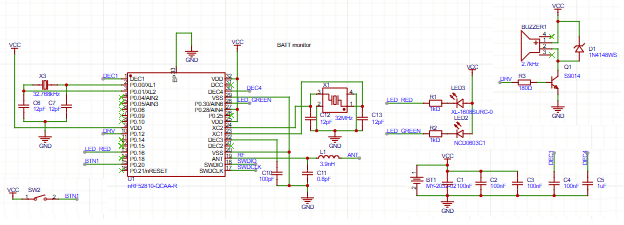nRF52810 board will not start on its own. It needs the RTT Viewer to be connected, then it will start and run. It has run on its own before with this configuration:
CONFIG_CLOCK_CONTROL_NRF_K32SRC_XTAL=y
PS:
Regards,
nRF52810 board will not start on its own. It needs the RTT Viewer to be connected, then it will start and run. It has run on its own before with this configuration:
CONFIG_CLOCK_CONTROL_NRF_K32SRC_XTAL=y
This issue is common to see when the 32kHz crystal is missing, the RTT viewer start ste device in a debug mode so then it simulates it internally.
Doas all SW not work or just yours?
Have you tested something else?
Regards,
Jonathan
All my SW does not work.

Have you tested som basic samples ?
Yes, I did.
I made a bare metal code that blinks LED. This code starts up on itw own upon power up. Could the problem be in Zephyr start up code and configuration?
Can you share a PDF file of the schematic, the resolution here was not great and a bit difficult to read.
If you are able to flash and debug as well as rund at least some code on the device then I suspect the main issue is some configuration in SW.
Might be related to the use of the LFXO and if it is used or not but can also be a HW issue. Is it mounted correctly ?
Regards,
Jonathan
Her is the schematic pdf:
I cannot get a waveform from both LFXO and HFXO since the start. Could this be why, eventhough, I enabled internal RC?
Looks like the VDD on pin 32 has the wrong component value, should be 4.7uF but you have 100nF.
When a debugger attaches to the device, it forces power and clock domains to remain on, which can mask power-related issues in your application. That is what I am suspecting happens in your case.
Also you do NOT have DCDC on this design so you need to make sure that the device only runs software that has DCDC disabled.
See if the external crystals are mounted the correct way. the LFXO (32kHz) should work, but the HFXO(32MHz) can be mounted wrong if rotated 90 degrees. So double check that.
Maybe try to use the synth clock:
Belive these should do.
Regards,
Jonathan
Looks like the VDD on pin 32 has the wrong component value, should be 4.7uF but you have 100nF.
When a debugger attaches to the device, it forces power and clock domains to remain on, which can mask power-related issues in your application. That is what I am suspecting happens in your case.
Also you do NOT have DCDC on this design so you need to make sure that the device only runs software that has DCDC disabled.
See if the external crystals are mounted the correct way. the LFXO (32kHz) should work, but the HFXO(32MHz) can be mounted wrong if rotated 90 degrees. So double check that.
Maybe try to use the synth clock:
Belive these should do.
Regards,
Jonathan
See if the external crystals are mounted the correct way. the LFXO (32kHz) should work, but the HFXO(32MHz) can be mounted wrong if rotated 90 degrees. So double check that.
HFXO is mounted correctly.
CONFIG_CLOCK_CONTROL_NRF_K32RC_SYNTH=yCONFIG_CLOCK_CONTROL_NRF_K32RC_XTAL=n
These settings did not work.
Even the Blinky example will not start on its own unless RTT viewe is connected.
I would appreciate a reply.
Regards,
What version of the SDK are you using ?
When using RTT Viewer the device is forced in debug mode, so that is why. Debug mode forces a few settings power and clock. In your other projects you dont have the configs correctly set up so that is why only debug mode works.
See: https://devzone.nordicsemi.com/f/nordic-q-a/98203/nrf52832-can-not-run-without-debugger/418083
https://devzone.nordicsemi.com/f/nordic-q-a/112027/segger-rtt-viewer-connection-latches-device-to-high-power-if-not-disconnected/488497
Are you disabling the DCDC?
Regards,
Jonathan
Yes DCDC is disabled.
I will let you know what happens after I changed the cap to 4.7uF.
Can you also share what SDK version you are using?